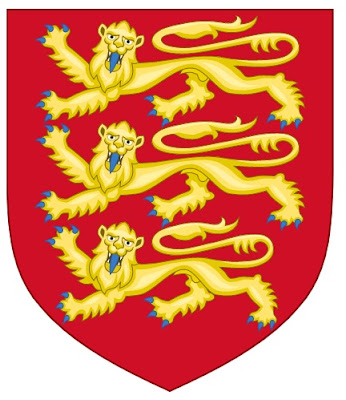Having just started the emblazonment of the arms of Mrs. Margaret Hockenhull, late wife of John Hokenhull of Prenton," 1613, I noted that there is no tincture given for the field of the Shotwick quarter and that the Hockenhull arms are noted as being in the 2nd and 3rd quarters rather than the 1st and 4th.
The first port of call (for the tincture of the shield) is, as always, Burke's but there is no entry for Shotwick. So, I looked for what I could find on Shotwick Hall and came across details of these arms in the Transactions of the Historic Society of Lancashire and Cheshire, 12th March 1914, Shotwick Hall.
"Transactions Historic Society of Lancashire and Cheshire 12th March 1914
Shotwick Hall
In the parlour, to the right, there is a carving over the mantelpiece, disfigured by successive coats of paint ; in the centre are the arms of Hockenhull of Hockenhull and Shotwick, with helm and mantlet, viz. Crest on a wreath, party per fesse, Argent and Or, a buck's head and neck erased, attired Or, pierced through the nostrils with a dart in bend of the last, feathered Argent, barbed Azure.
Arms Quarterly, 1 and 4, a plain cross [Shotwick] ; 2 and 3, Argent, an ass's head erased Sable [Hockenhull].

In regard to the Shotwick arms, nothing is obtainable at Heralds' College, but from the funeral certificate of " Mrs. Margaret Hocknell, late wife of John Hokenhull of Prenton," 1613, they appear to have been a plain cross Sable, and these arms are shown in the first and fourth quarters of an achievement over a mantelpiece in the present Hall, with the date 1662, Hockenhull occupying the second and third quarters (see p. 68). The placing of the arms of Shotwick in the first and fourth quarters is curious, especially as the Hockenhulls did not sell their manor of Hockenhull until some fifty years later, and perhaps argues that they considered Shotwick the more important possession. In earlier times, it is true, the great folk regarded their quarterings less as marks of identity and evidences of descent than as emblems of their seigniories, placing the most important first; but the present instance seems a very late survival of that practice. Perhaps, however, the arms were copied from an old seal. In Scotland quarterings also implied the possession of lands. This was so much the case that, though the third Marquess of Montrose (d. 1684) married Lady Christian, younger daughter and co-heiress in blood of John Leslie, Duke of Rothes, yet, as she did not share in her father's lands, her arms have not been quartered in the Montrose escutcheon as they would be now. In foreign coats quarterings are often employed to denote the possession of fiefs acquired in other ways than by marriage, e.g. by bequest or purchase, or even the jus expectationis. In Harl. MS. 2187, fo. 66b, there are depicted the crest and coat of Hockenhull, the latter quartering 2 and 3 Argent a cross Sable ; the cross is faintly drawn in pencil as voided, but the tinctures are denoted by the letters A and S in ink. In Harl. MS. 1535, fo. 35b, a shield is reserved for Shotwick, but no arms are filled in."



















































